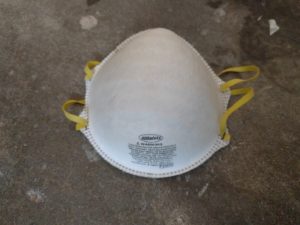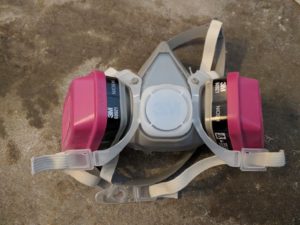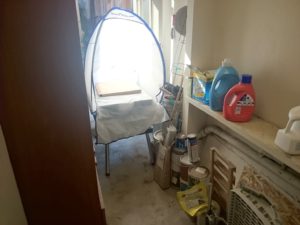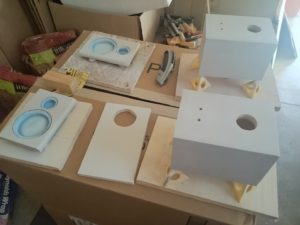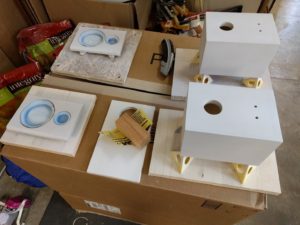In which we try rattle-can spray painting for the very first time…
Wear A Respirator Mask!
Before we get started, there is one word of caution that I would like to add: If you do any kind of spray painting, get a serious respirator mask!
This is NOT a respirator mask suitable for spray painting:
While this works fine for dust particles, like when you are woodworking, this does pretty much nothing for the fumes from a spray can.
You want something like this:
Including the (replaceable) filters, a respirator mask like that will set you back approximately USD 35.- but spray can fumes are nasty and you need your lungs to last you a lifetime…
And yes, even if you spray paint outside I do recommend that you get one of these. Your face will be fairly close to the object you are spray painting and hence to the fumes from the can.
Setup
We live in a very windy neighborhood. While ventilation is good for spray painting, it is definitely too windy to do it outside, or the paint will go all over the place, let alone talk about dust getting kicked up and being deposited on your wet spray paint.
We have a garage that has a narrow walk way leading out to the backyard. So I decided to open the back door and set up my spray painting work station inside the garage, but right at the back door.
I splurged somewhat and got a small spray shelter but I think this is not really necessary. Overspray turned out to be far less than I expected.
Also, I put some cardboard in the bottom and the sides of the spray shelter to avoid messing it up too badly. — At the end I got this:
I also hunted four small pieces of wood scraps, to individually place each of the cabinets and baffles I wanted to paint on. This would allow me to easily move them in and out of the spray shelter and to turn them without touching them while spraying.
I used my painter spikes for the cabinets, but I did not have enough for the baffles, so I got some aluminum foil from the kitchen and formed 8 small balls, four for each of the baffles, to raise the baffles slightly from the surface they were resting on.
Painting
Basic Technique
Start spray painting by shaking the rattle-can forever… (The label on my can said “for at least two minutes AFTER the ball inside the can starts to rattle”).
Then, make sure to aim the nozzle to a spot right next, but not onto your work piece, depress the nozzle to start the spray and move the can across your work piece, releasing the nozzle once you are off the work piece again.
I can confirm that if you accidentally aim the can at your work piece you get paint runs pretty much immediately…
How May Coats of Primer?
More coats but thinner coats are better they say… Not sure what constituates a “coat”, but what I did was to paint all four pieces, which took a couple of minutes, then go back to the first piece and do another thin coat. I think I did this three times. — In two cases I ended up messing up the paint a little and got some paint runs. — I used some cloth to wipe this up. Not sure if that is a good idea, because it definitely gives you a slightly rougher surface.
The primer is dry to the touch within minutes. I gave things a couple of hours and then carefully sanded the rough spots and after 24 hours I did a touch-up with the primer on the baffles and re-sprayed a single coat on the cabinets. However, I think this was mostly unnecessary, but judge for yourself. First picture is after first day of priming, second picture is after second day. The additional work piece is a scrap piece of plywood that I used to test things out first. This scrap piece only got a single coat of primer. Apparently it is easier to prime plywood than MDF…
How Much Primer Did You Use?
Actually more than I expected. For both coats on all the work pieces I ended up using almost an entire can of primer.
Comments on Spray Painting
I already told you to wear a respirator mask!
These things work really well. I couldn’t smell the fumes at all, but after I was done I took the respirator off and realized that I had stunk up the entire house, even tho all windows and the door leading to the garage were closed.
There was a brief moment of panic when I saw some fumes rising from my work station, thinking that despite the spray tent I was about to release a ton of primer pigments onto the exterior of the house. Well, turns out it was really just fumes that the sun hit just right.
So wear a respirator mask!
Overall overspray (at least when spraying primer) was not as bad as I thought and for the second round of priming I ditched the spray tent and just set up some cardboard in a corner by the back door and it worked just fine.
The spray tent will come out again when I do the final coating (ie not priming), since I have a suspicion there might be smaller particles involved.
